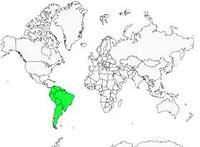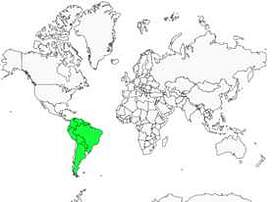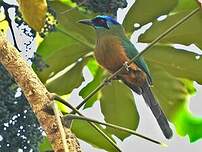Amazonian Motmot
Momotus momota - Motmot houtouc
Identification
The Amazonian Motmot is one of the species derived from the old taxon Momotus momota, which was split into six species in 2009: Blue-capped Motmot (M. coeruliceps), Lesson's Motmot (M. lessonii), Caribbean Motmot (M. subrufescens), Trinidad Motmot (M. bahamensis), Ecuadorian Motmot (M. aequatorialis) and, of course, the Amazonian Motmot (M. momota). These six species are very similar, but their ranges do not overlap much. The best way to distinguish them is to take note of the place of observation.
The Amazonian Motmot measures between 40 and 45 cm in length, including its tail, and weighs about 145 g. The upper parts are green, going to a bluish hue on the remiges and especially on the tail. The latter has two long central feathers ending in blue oval shapes. The underparts are reddish-orange; the intensity of this color varies in the nine subspecies. Some black feathers can be observed in the center of the breast. The head shows a large black mask that covers the dark red eye and highlights the blue-turquoise crown. The top of the head is black and bordered at the back with royal blue. The mask is bordered by a thin turquoise line. The slightly jagged beak is dark gray, as are the legs. There is no dimorphism between the sexes.
Subspecific information 9 subspecies
- Momotus momota momota (e Venezuela, the Guianas and n Brazil)
- Momotus momota microstephanus (se Colombia, e Ecuador and nw Brazil)
- Momotus momota ignobilis (e Peru and w Brazil)
- Momotus momota nattereri (ne Bolivia)
- Momotus momota simplex (w Brazil to wc Brazil. s of the Amazon.)
- Momotus momota cametensis (nc Brazil)
- Momotus momota parensis (ne Brazil)
- Momotus momota marcgravianus (e Brazil)
- Momotus momota pilcomajensis (s Bolivia, s Brazil and nw Argentina)
Foreign names
- Motmot houtouc,
- Momoto amazónico,
- udu-da-amazónia,
- Amazonasmotmot,
- Diadém-motmot,
- Amazonemotmot,
- Motmot capoblu,
- amazonmotmot,
- Blåpannemotmot,
- momot pílkozobý,
- momot černolící,
- Rubinmotmot,
- siniotsamomotti,
- motmot amazònic,
- piłodziób wspaniały,
- amazonski motmot,
- Синешапочный момот,
- ハチクイモドキ,
- 亚马逊翠鴗,
- amazonmotmot,
- 亞馬遜翠鴗,
Voice song and call
Its song consists of the monotone repetition of woop spaced out by a few seconds. The note, deep and low in pitch but still quite high, can remind of the sound of some owls. Couples can sing in duet and one can hear a tremolo of notes on these occasions. The alarm call is a repetition of touc hits, as if someone was tapping on wood. The note can double, coutouc coutouc... and other notes can appear heinc heinc heinc.... Amazonian Motmot's song consists of a single deep and high-pitched monotone woop spaced by a few seconds and can be imagined as the sound of some owls. When singing in duet, one can notice a tremolo of notes. The alarm call consists of a repetition of touc hits, replicating the sound of someone tapping on wood, and can also double, coutouc coutouc... or produce other notes such as heinc heinc heinc....
Habitat
The Amazonian Motmot particularly loves tropical forests (both lowland and middle altitude up to 1700 metres), but is quite ecologically flexible: it can also be found in dry forests (of the Chaco type) or arboreal savannas (of the cerrado type) and even in anthropised zones (plantations, suburban areas with gardens...).
Behaviour character trait
Flight
Dietfeeding habits
The Amazonian Motmot is mainly insectivorous (beetles, mantids, crickets, caterpillars...), but also regularly eats fruits and even small reptiles. It catches its prey directly from the ground, very rarely in flight. When its prey is too big, it strikes it against a branch before swallowing it.
Reproduction nesting
The breeding season extends from July to November depending on the region. Like other Coraciiformes, the Amazonian Motmot digs its nest in the banks of rivers. In the forest, in the absence of a river, it can take advantage of existing burrows, especially those of armadillos, to dig its own horizontal gallery, which can measure up to one meter long. The female lays 3 or 4 white eggs. Both parents take care of the excavation of the nest, the incubation of the eggs and the feeding of the young.
Geographic range
The Amazonian Motmot can be found throughout the Amazon Basin and the adjacent southern regions of the Amazon: from central Colombia to the extreme north of Argentina and Paraguay (only east of the Andes Mountains), as well as south of Venezuela, in the Guyanas and northern and central Brazil. Nine subspecies share this vast space. The M. m. marcgravianus subspecies is geographically separated from the other eight and is found in a small zone of the northeastern Brazilian Atlantic Forest.
Threats - protection
IUCN conservation status
concern
in the Wild
threatened
evaluated
Classified as of minor concern due to its wide distribution range, the Amazonian Motmot species is nevertheless suffering from the loss of its habitat due to deforestation. The global population is in decline.
Sources of information
- IOC World Bird List (v15.1), Gill, F and D Donsker (Eds). 2025-12-07.
- A Field Guide to the Birds of Brazil, Ber Van Perlo
- Birds of Colombia, Steven L. Hilty and William L. Brown
- Birds of Peru, Thomas S.Schulenberg, Douglas F.Stotz, Daniel F.Lane, John P.O'Neill, Theodore A.Parker III
- Handbook of the Birds of the World Vol 16, Josep del Hoyo, Andrew Elliott, David Christie
- Birds of the World, The Cornell Lab of Ornithology
- Wiki Aves,
Other sources of interest
 Specification sheet created on
30/07/2023 by Dietmar Petrausch
Specification sheet created on
30/07/2023 by Dietmar PetrauschTranslation by AI Oiseaux.net
© 1996-2025 Oiseaux.net
- Accipitriformes
- Aegotheliformes
- Anseriformes
- Apodiformes
- Apterygiformes
- Bucerotiformes
- Caprimulgiformes
- Cariamiformes
- Casuariiformes
- Charadriiformes
- Ciconiiformes
- Coliiformes
- Columbiformes
- Coraciiformes
- Cuculiformes
- Eurypygiformes
- Falconiformes
- Galliformes
- Gaviiformes
- Gruiformes
- Leptosomiformes
- Mesitornithiformes
- Musophagiformes
- Nyctibiiformes
- Opisthocomiformes
- Otidiformes
- Passeriformes
- Pelecaniformes
- Phaethontiformes
- Phoenicopteriformes
- Piciformes
- Podargiformes
- Podicipediformes
- Procellariiformes
- Psittaciformes
- Pterocliformes
- Rheiformes
- Sphenisciformes
- Steatornithiformes
- Strigiformes
- Struthioniformes
- Suliformes
- Tinamiformes
- Trogoniformes






























